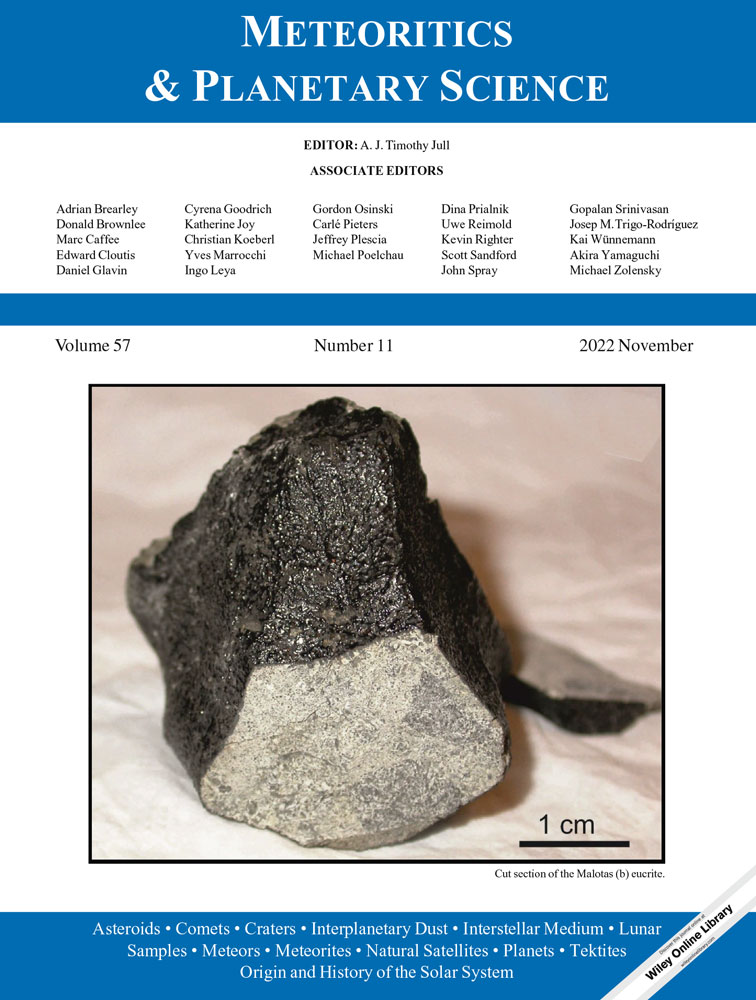Mincy mesosiderite metallic nodules analyzed by EBSD: An approach to understanding their thermal history
Abstract
Meteorites carry information about the most common processes that have been active in the early solar system. In particular, mesosiderites are meteorites with a structure considered to be composed of equal parts of iron–nickel metal and silicates. A natural delimitation in the study of such complex systems is the discrimination of the iron–nickel metallic and silicate domains. In this work, we focus on the metallic phases of the Mincy mesosiderite, a specimen available at the Instituto de Ciencias Astronómicas, de la Tierray y del Espacio repository. In Mincy, the metallic phases are iron–nickel–carbon alloys that are distributed forming metallic lumps or pebbles (referred to as metallic nodules in the article) in which kamacite and taenite are present, and taenite is found both at the kamacite/silicate interface and surrounded by kamacite, that is, isolated from the silicates. We made use of the electron backscattered diffraction technique to determine the crystallographic orientation relationships along the taenite/kamacite boundaries as well as for characterizing the (hkl)-specific grain boundaries regarding the underlying tilt, twist, or twinning mechanism to assist the interpretation of the phase transformations and mechanisms that could explain the formation of these metallic nodules. From the results, each of the metallic nodules has a unique temperature–pressure history and kinetics to undergo phase transformations (mainly partial melting, heterogeneous nucleation-controlled solidification, and possible evaporation–condensation) as well as liquid-phase sintering and recrystallization in its own way.
Introduction
Other noteworthy research is the work carried out by Yang et al. (2011), who conducted optical microscopy (OM), scanning electron microscopy (SEM), and EBSD studies on six reheated iron meteorites showing recrystallized taenite and kamacite mainly at grain junctions, that is, grain boundary allotriomorph (GBA) with preferred orientations (K–S and N–W) and special interfaces including subgrain boundaries (SGBs) developed after Widmanstätten/Plessite (W/P) original pattern. Two of the meteorites were reheated below 700–750 °C and retained a record of the initial WP, while the other four, which were reheated above 600–700 °C, did not.
More recently, Zachén et al. (2019) described the metal microstructure of the Vaca Muerta mesosiderite employing EBSD. They were able to identify thin and broad WP together with relict taenite crystals. More significant were the sample regions where they found the γ phase forming round instead of linear features. They proposed that these regions were not part of the WP and had been formed by another process. Other particular features were the 500 μm to 1 mm sized interconnected blebs of monocrystalline kamacite. They observed that this peculiar kamacite microstructure outlined the WP and often contained central inclusions of troilite, schreibersite, merrillite, chromite, and silicates including plagioclase, pyroxene, and SiO2. Apparently, kamacite in these features followed the shape of the central inclusions. They suggested that these blebs would be the result of amalgamations of eutectic phases as inferred by their positions and shapes. Finally, they referred to the taenite phase inside the interstitial spaces, which had different CORs as compared to the WP taenite phases. The authors concluded that the interstitial spaces would have been remelted at some point, followed by recrystallization resulting in the second generation of the γ phase with a different orientation which is not compatible with a relic-taenite scenario.
In this paper, the results of a detailed EBSD study of the metallic regions in a sample of the Mincy mesosiderite are presented. Mincy meteorite was found in Missouri (United States) in 1857 and its total weight was 89.4 kg. It is a mixture of coarse-grained silicates and metallic phase, most of which displays a well-developed Widmanstätten microstructure. Nevertheless, taenite and kamacite phases can also be occasionally associated in metallic lumps or pebbles (from now on referred to as metallic nodules). In the latter case, one or two irregularly shaped taenite regions are partially or totally enveloped by kamacite (Powell, 1969). This is the case of the sample under study in this research named Mincy L. The CORs along the γ/α boundaries were measured and compared with the common orientation relationships to assist the interpretation of the phase transformations and mechanisms that could explain the formation of the metallic domains in Mincy in particular and in mesosiderites in general. Furthermore, the (hkl)-specific grain boundaries of taenite and kamacite were characterized regarding the underlying tilt, twist, or twinning mechanism in a possible shock and reheated process which is crucial to understand the formation, deformation, and cooling history of the Mincy carrier body.
Methods
The scanned metallic regions in the Mincy L mesosiderite sample are indicated in the panoramic OM image in Fig. 1. Each of these areas was identified as a nodule (“N”) and numbered from 1 to 9. From the reference coordinate system in Fig. 1, the Z axis is normal to the finely polished surface of the sample, whereas the X and Y axes are the reference directions within the sample surface, following the criteria adopted by Nolze et al. (2005). The sample was prepared for a traditional metallographic investigation: polished with emery paper up to 2000 grade and subsequently polished with diamond paste to 0.25 μm. At this point, provisory measurements were performed on N1, N2, N5, and N9. Later, the sample was polished on a vibratory polisher with 0.05 μm colloidal silica for 4 min to eliminate any artifacts on the surface that could alter the quality of EBSD measurements, remarkably sensitive to the surface preparation (Nolze et al., 2006). The remaining metallic domains, that is, N3, N4, N6, N7, and N8, were studied in this new condition which improved the percentage of indexed points to be included in the confidence index (CI) value.

Forward scatter (FWS) detector images for each nodule were registered to evaluate the nodules and their surrounding structure. These images together with the Kikuchi patterns were acquired by using the TSL EDAX system mounted on a field emission gun scanning electron microscope (Quanta 200-FEI). Two types of scans were developed: one of them with a step size from 2 to 5 μm for general inspection and the other one with a step size of 70 nm to register some particular details. The data were analyzed with the TSL OIM 7.3b software. The scans were cleaned using a CI standardization routine and the pixels were filtered by a CI >0.2 or by the mean CI of each partition. This clean-up routine replaces the CI of the scanned points by the maximum CI value on the grain and does not change any other data except the CI value. Nevertheless, it was always verified that the filtering routine did not affect the information about the nodule microtexture.
After processing, the inverse pole figure (IPF) maps of both bcc and fcc structures were obtained from which the spatial distribution of the phases can be evaluated with respect to the Z axis, that is, to the normal of the polished surface. In each of the IPF maps, the reference triangle for the cubic crystal system was superimposed. The common color code for cubic materials was used: (1) red: [001] direction of the crystal is parallel to the Z axis, (2) blue: [111] direction is parallel to the Z axis, (3) green: [101] direction is parallel to the Z axis. In addition, the IPFs of the bcc phase were generated, which represent the distribution of a selected direction in the specimen (X, Y, or Z according to the coordinate system in Fig. 1) in relation to the crystal axis and are useful to estimate the dispersion in its grains' orientation. Finally, the pole figures (PFs) of both phases were attained, which are essentially the projection of crystallographic directions in the sample frame of reference.
Results
The results will be presented in two different subsections according to the polishing procedure, that is, before and after the sample was polished with colloidal silica.
EBSD Before Colloidal Silica Polishing
Nodule 1
Two different regions of Nodule 1 were explored, the first being introduced in Fig. 2a. The island-like monocrystalline kamacite (bcc-α) domains are dispersed in a silicate matrix and appear to be separated from each other around the taenite (fcc-γ) region. Nevertheless, from Fig. 2b and 2c, kamacite forms a continuous domain in terms of crystallographic orientations through the bcc/silicate phase interfaces. Besides, from blue color dominance in these figures, kamacite is almost monocrystalline with the [111] crystallographic direction perpendicular to the sample polished surface. This is also supported by the Z-axis kamacite IPF in Fig. 2e and PFs in Fig. 2f, from which most of the crystals in this kamacite region have their [111] direction nearly aligned with the sample's normal direction with low dispersion in grains' orientation both in this direction and its perpendiculars. From the analysis of PFs in Fig. 2f, all the fcc regions (isolated in Fig. 2d) belong to the same four sets of twinned fcc variants adjoined with each other by the {111} twin plane, that is, high-angle (70.5°) < 110 > {111} symmetrical tilt boundaries as confirmed by the pole position measurements. These four fcc variants are likely growth twins rather than deformation twins as they would otherwise be polysynthetic. Near N–W orientation was registered, as pointed out by arrows in Fig. 2f.
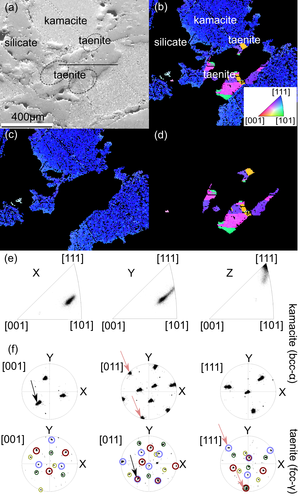
The second region explored in Nodule 1 is presented in Fig. 3a and 3b. In this case, most of the kamacite crystals have their [111] direction nearly aligned with the sample's normal direction although the dispersion in grains' orientation is higher compared to the first analyzed area (Fig. 3c and 3e). From the PFs (Fig. 3f), the fcc variants are twinned, with no optimum CORs with the bcc phase.

Nodule 2
In this nodule, taenite develops in two different regions: in contact with the silicates and isolated from them, that is, in the upper left corner and central region, respectively, in the FWS image and the IPF maps (Fig. 4a–d). In this latter situation, taenite is enveloped by kamacite which progressively changes its subgrains' disorientation from the area in contact with the silicates/taenite interphase in the upper left corner to the zone of diffuse grain boundary that is in direct contact with the silicates in the lower right corner (Fig. 4c and 4e). The two taenite regions with such different neighborhoods are not crystallographically correlated and no optimum CORs were recognized (Fig. 4f).
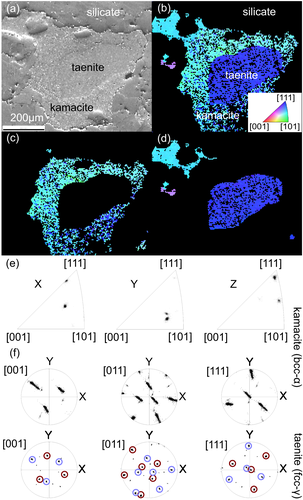
Regarding the extent of misorientation, a detailed scan of 70 nm step size was developed in a portion of the kamacite domain in contact with the silicates whose IPF map is available in Fig. 5a. The resultant local orientation spread (LOS) map (Schwartz et al., 2009) in Fig. 5b shows that the low-angle grain boundaries (LAGBs, misorientation angle ≤15°) correspond to 95% of the boundaries and that they tend to be straight. Furthermore, in Fig. 5c and 5d, the colors representing the grain boundary misorientation angles as referred to in Fig. 5b are correlated with the kamacite IPF figure and with the microstructure. The domains within the scanned area vary from green to red with no overall spatial trend, although they do vary systematically in the IPF plot. The long straight lines that are easily distinguished in Fig. 5a and 5b are polishing scratches with dislocations that may affect misorientations. This artifact was removed by additional colloidal silica polishing as addressed later.
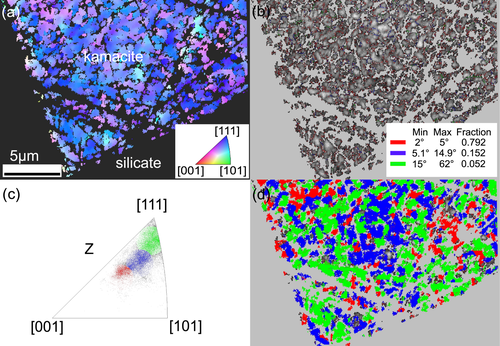
The kamacite/isolated taenite interface was also explored through a detailed scan. Mostly LAGBs were observed in the kamacite phase near the interphase, whereas just a very few were detected in the taenite phase as from the LOS map in Fig. 6a. The condition of taenite is confirmed from the lower part of the IPF map of the interface in Fig. 6b, as no dispersion of orientations is observed.
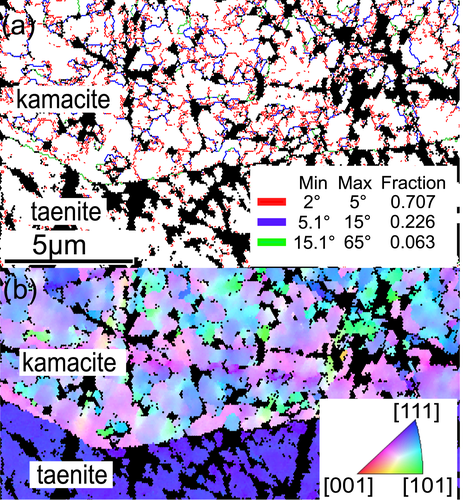
Nodule 5
As presented in the FWS image and IPF map in Fig. 7, in this nodule, the subgrains' misorientation in kamacite is evident, while the almost isolated taenite remained monocrystalline. From the analysis of the PFs (not shown, as it might be redundant), kamacite and taenite do not follow Bain, K–S, or N–W CORs.
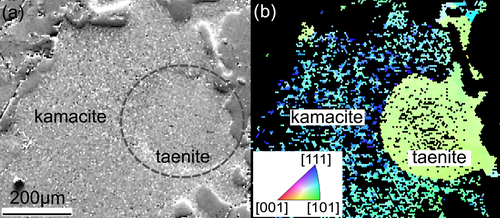
Nodule 9
As in Nodule 1, the FWS image and IPF map of Nodule 9 in Fig. 8 show that kamacite is almost monocrystalline while polycrystalline taenite forms at the bcc/silicate interphase. From the analysis of the PFs (not shown, as it might be redundant), kamacite and taenite do not follow any of the most common CORs.

EBSD After Colloidal Silica Polishing
Nodule 3
In this nodule, monocrystalline kamacite is filling a narrow region between silicates (Fig. 9a and 9b). The orientation of kamacite at both sides of the narrowing is similar, as can be inferred from the IPF map in Fig. 9b. Multiple I, II, and III twin variants in taenite as well as recrystallized taenite (pointed out in Fig. 9c IPF map) with irregular grain boundaries grown at the expense of blue twin variants were recognized. The [001]γ ~ parallel to the sample Z axis (red domain in the IPF map in Fig. 9b and 9c) has a planar interface ~(111)γ//~(110)α with the neighboring bcc domain, following the K–S COR based on the PFs as indicated by the arrows in Fig. 9d. The primary {111} twin boundaries are again predominant for the taenite twin variants in the nodule.
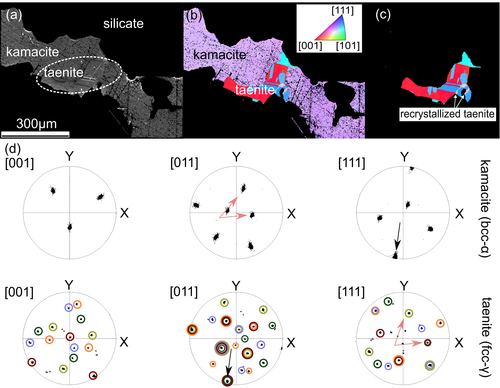
Nodule 4
Two regions were scanned in Nodule 4. The IPF map of the first one is indicated in Fig. 10a where two kamacite grains can be distinguished, that is, kamacite is not monocrystalline as in previous cases (Nodules 1 and 2) considering the two <001> poles in the IPFs in Fig. 10b. Pole measurements indicate that the two kamacite grains are approximately 55° off by the tilting of the <111> axis. In addition, taenite at grain/phase junctions has multiple closure twin variants, as identified in the IPF map.
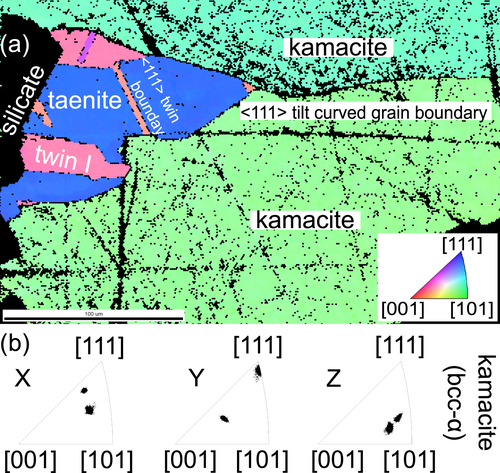
Concerning the second region scanned in Nodule 4, multiple I and II twin variants of taenite were identified and indicated in the IPF map of Fig. 11a. The two {111} fcc twin variants are related by 60° rotation around the normal of the twin-I plane or twin-II {111} plane. Predominant (111) twin boundaries for pink and blue variants and occasional ~<111/001>interface were recognized, which would develop into the [101] asymmetrical tilt boundaries by the adjoined {111}/{010} planes. From the inspection of kamacite and taenite orientations (kamacite green domain and taenite pink domain in the IPF maps in Fig. 11a and their PFs in Fig. 11b), they were found to follow {111}γ~//~{110}α and {110}γ~//~{111}α which are ~20° off from K–S COR.
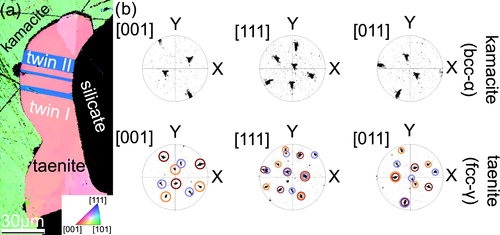
Nodule 6
According to the kamacite IPF map in Fig. 12, there are two different orientations in the kamacite regions. Although the complex and strong plastic deformation to which the meteorites are exposed frequently reduces the reliability of the CORs (Nolze, 2005; Nolze et al., 2006), the taenite with predominant green domain in the IPF map in Fig. 12c and the orientation-dispersed kamacite were found to very closely follow the ~K–S relationship based on the inspection of PFs in Fig. 12d. The pole measurements for taenite confirms that there is one major dispersed orientation (circled in dark green) and one minor orientation (circled in lilac) both following the primary {111}fcc twin relationship. It is the predominant green domain in the taenite IPF map (Fig. 12c) that follows the ~K–S relationship with the adjoined kamacite islands with major orientation in pink (Fig. 12b), as indicated by arrows in Fig. 12d. In Fig. 12c, the portion of the taenite phase which is further inspected in Fig. 13 is emphasized.

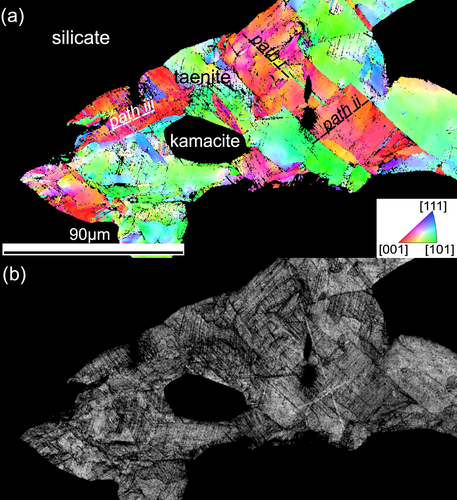
Abundant (hkl)-specific grain boundaries were characteristic only to this considerably deformed nodule. As they were not expected to be polishing artifacts (in this study, mainly grinding grooves as from Figs. 2-6), then the grain boundaries were further examined by misorientation measurements along the three transverse traces in Fig. 13a (paths i, ii, and iii). There are rather complicated ~{110} vicinal (including {112}) deformation bands approximately 5–20 μm in width with varied orientations analogous to Neumann bands for kamacite. As to the taenite grains in this significantly deformed nodule, they are misoriented across some low- and high-angular grain boundaries (LAGBs and HAGBs, misorientation angle <15° and > 15°, respectively). They turned out to be the (hkl)-specific grain boundaries: (i) ~ {010} vicinal twist boundaries with specific misorientations, that is, approximately 10, 30, 40, 50 (=40), and 60 (=30)° with the complementary angle in parentheses; (ii) (111)/(100) HAGBs; (iii) {010} and ~{111} vicinal slip bands approximately 2–3 μm in width. The image quality map (Fig. 13b) allowed the authors to recognize twins and multiple microtwins in taenite. There are mosaic closure microtwins with (111) and (100)-specific boundaries.
Nodules 7 and 8
These two entirely kamacite nodules were scanned in order to check whether this bcc phase was monocrystalline with the [111] crystallographic direction perpendicular to the sample, as in Nodules 1, 2, and 9. In Nodule 7 (Fig. 14a), the almost monocrystalline kamacite with considerably dispersed [001] pole distribution (not shown, as it might be redundant) presents (hkl)-specific LAGBs in a diffuse manner surrounded by silicates while in Nodule 8 (Fig. 14b), kamacite is perfectly monocrystalline. The misindexation and lack of indexation points in the upper part of the kamacite in Nodule 7 are probably associated with polishing problems as the nodule is within the limit of the sample, in contact with the hard support material.
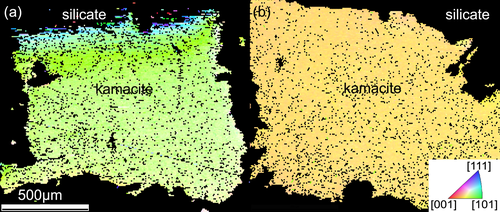
Discussion
Preferred Orientations of the Metallic Nodules
Preferred orientations of kamacite and taenite in metallic nodules were evident from the results. In particular, the <111> orientation for the appeared-to-be separated kamacite islands in Nodule 1 must have been beneficial for kamacite and taenite to reach near N-W COR. Shock pressure may be the cause for the preferred orientations of fcc and bcc phases in terms of close-packed planes. In fact, kamacite in Nodules 2, 5, and 9 also have the [111] preferred direction pointing out the scanning surface, some with abundant low-angle grain boundaries which can be attributed to shock-induced hot working/recrystallization of kamacite in a ductile regime. The erratic shape and wide distribution of the poles for taenite and kamacite in Nodule 6 also reflect an even more severe deformation path of the metallic phases as also suggested for the orientation relationships of kamacite in the north Chile iron meteorite (Nolze et al., 2006). This indicates a rather diversified stress state of metallic nodules after their bonding with the silicates in a dynamic shock process involving random particle collisions.
(hkl)-Specific Grain Boundaries of Taenite and Kamacite: Type and Energetically Favored Variants
The {111} twin boundary of taenite, as also commonly observed for austenite in stainless steel, is a coherent grain boundary and hence energetically more favorable than the semicoherent {101} twin boundary given the same twin law of {111} twin plane and <101> twin axis. Such a coherent twin boundary can be regarded as a special {111} twist boundary by 60° rotation around the threefold <111> axis of the ABC layer stacked fcc, or a special symmetrical {111} tilt boundary by 70.5° rotation about the [101] axis, that is, the so-called Σ3 {111} (70.5°) <110>{111} symmetrical tilt boundary. Thus, the {111} twin boundaries can be readily fabricated by the twist or tilt of the bicrystal in terms of the close-packed planes and hence common for the fcc-type crystals formed via the deformation (Kumar et al., 2016), growth, and/or coalescence-rotation mechanisms (Lin et al., 2014). Furthermore, mosaic closure twins are common at grain boundaries/junctions with significant matrix constraint or sintering stress. In any case, a coherent {111} twin boundary would be truncated at the lateral edge as an incoherent boundary and a significant torque term at the hinge (Porter et al., 2009) would urge its migration coupled with grain rotation into local energy cusps, such as the {101} twin boundary or the occasional {111}/{001} <101> − 54.7° tilt boundary. In this regard, the 60° rotation about <111> for twinning domains in the second area of Nodule 4 would lead to the “approach” of {111} and {100} pole with 19° (54–35 = 19°) misfit in between. The misorientation-dependent energy or the torque term at grain junction would trigger effective migration of metastable interface, or the so-called high-order twin boundary (Kumar et al., 2016), coupled with grain rotation into the stable primary {111} twin boundary. An intermediate interface with local energy cusp such as the {111}/{001} interface, that is, {111}/{001} <101> − 54.7° tilt boundary may be encountered as pertinent to the case of the adjoined NiO nanocrystals with fcc-type Ni and O sublattice upon annealing (Yeh et al., 2010) and the bimetallic Au-Cu nanoparticles via a laser ablation condensation route (Lin et al., 2014). It is worthwhile noting that high-order twin boundaries (Σ9 and Σ27) based on ~{111} vicinal interface besides the primary (111) twin boundaries (Σ3) also occurred in nickel-based superalloys when subject to isostatic compression under varied strain rates (Kumar et al., 2016).
There are additional LAGBs and HAGBs for taenite when severely deformed, for example, in Nodule 6. In such a case, the ~{010} vicinal twist boundaries having various misorientations yet with fair coincidence site lattice (CSL) and hence beneficial local energy cusp prevailed along with some hetero (111)/(100) and {111}/{110} HAGBs as well as {010} and ~ {111} vicinal slip bands. The co-existent kamacite in such a seriously deformed nodule has rather complicated ~{110} vicinal (including {112}) deformation bands with varied orientations analogous to Neumann bands for kamacite (Uhlig, 1955).
Genesis of Metal Nodules in Silicate Matrix-Phase Transformation Route
The taenite and kamacite in the above-mentioned nine nodules being embedded in silicate matrix and each with characteristic preferred orientation and (hkl)-specific grain boundaries shed light on the underlying phase transformation paths for the present Mincy L mesosiderite. First of all, the liquid phase is kinetically favored for effective sintering of metal and silicate particles as a ceramic–metal composite (i.e., the so-called cermet) in a dynamic shock process. The liquid is mainly due to the partial melting of metals with a much lower melting point than silicates. Subsequent solidification of the partial melt caused the nucleation and growth of taenite which adjoined with the kamacite relict as diversified microstructures in the nodules depending on the nucleation sites for melt and crystal as well as the extent of solid-state modifications as addressed in turn.
Generally, grain/phase boundaries are the preferred nucleation sites for partial melting and then crystallization as GBA in drastic contrast to W/P via the solid-state precipitation process (Porter et al., 2009). This is supported by the present results showing that polycrystalline taenite was indeed situated at the kamacite/silicate boundaries. It should be noted that polycrystalline taenite associated with kamacite and silicate formed mosaic twin variants with the primary {111} twin boundaries, presumably due to the rotation/coalescence of particles under the combined effects of residual liquid, sintering stress, and torque term at grain junction. Twinning growth from liquid/melt without a solid matrix constraint would otherwise form butterfly twins, which have been generally classified as growth twins rather than transformation, deformation, or coalescence twins (Lee & Shen [1999] and references therein). The lack of butterfly twinning as manifested by the absence of butterfly shape bicrystal in the taenite IPF map of EBSD means that the metal nodules were not simply crystallized from melt/fluid in a static environment. A more complicated dynamic process involving phase transformations (mainly partial melting, heterogeneous nucleation-controlled solidification, and possible evaporation condensation) as well as liquid-phase sintering, recrystallization, deformation, and coalescence processes are required to account for the diversified textures of metal nodules clastically adjoined with silicates.
On the contrary, monocrystalline taenite was identified when enveloped by kamacite, that is, when isolated from the silicates. Such monocrystalline taenite could be accounted for by partial melting of kamacite nodule at its dislocation outcrop with trapped impurities for a lower melting temperature followed by solidification of Fe-Ni melt at a relatively high temperature with higher growth than nucleation rate. This is in accordance with the taenite inclusions inside the blebs of monocrystalline kamacite for Vaca Muerta mesosiderite (cf. fig. 1c in Zachén et al. 2019). Besides, partial melting and vaporization at the outcrops of defects, mainly grain boundaries and dislocations with significant mobility, have been the focus of numerous investigations. For instance, Reisman et al. (1990) showed thermal grooves at dislocation outcrops to form etch pits in Si wafers after heating in the Ar atmosphere at specified temperatures; Palizdar et al. (2013) reported thermal pits at dislocation outcrops for low-C and Al-alloyed steel after heating up to austenite temperature and then quenched from 1150 °C in vacuum.
As to solid-state modifications, composition invariant and variant transformations may occur at relatively high and low heating/cooling rates, respectively (Porter et al., 2009). Apparently, the cooling rate and carbon contents are not high enough to form composition-invariant martensite from taenite, although other kinetic phase changes such as massive fcc→bcc transformation to form metastable bcc phase cannot be excluded at a moderate cooling rate. The composition invariant bcc→fcc transformation at high pressure has been experimentally proved for the Fe30Ni alloy with both fcc and bcc structures at ambient conditions, which became a single phase of fcc upon static compression at up to 20–60 GPa and various temperatures up to 600°C but hardly quenched to ambient pressure (Huang et al., 1992). As to the composition variant bcc→fcc transformation at a slow enough heating rate for solute repartition in the two-phase region of the equilibrium phase diagram, it is kinetically not favorable in the rapid heating process, particularly in the presence of liquid. The equilibrium fcc→bcc transformation would be pertinent to GBA (cf. fig. 1d in Zachén et al. [2019] for Vaca Muerta) at a cooling rate not slow enough to circumvent the formation of W/P, although prolonged dwelling at temperatures below 350–400 °C could cause metastable phase separation of taenite to form the so-called cloudy taenite with intimate intergrowth of kamacite and taenite with optional long-range ordering. Finally, recrystallization of both taenite and kamacite is expected under effectively applied stress at moderate to high temperatures. In this regard, recrystallized taenite grains with irregular grain boundaries at the expense of closure twins were indeed notorious in Nodule 3.
Implications for the Reheated Shock History of Mincy L
It should be noted that some metal grains show deformation whereas others do not. This sheds light on the reheated shock history of Mincy L mesosiderite. The different thermal/shock history and the critical resolved shear stress in terms of the crystal orientation and the applied stress state of the reassembled fragments may account for the selective deformation of the individual metal nodules in meteorites which have been subjected to asteroid impacts and terrestrial landing. In this connection, the fcc-type AuCu3 and Cu-doped Au particles, as produced by pulsed laser ablation of bulk AuCu in vacuum, were selectively deformed to show polysynthetic {111} twinning under the influence of strain relaxation and the shock effect (Lin et al., 2014).
High-temperature solidification alone would hardly yield diversified deformation textures for metal nodules. In this regard, liquid phase sintering of nickel-based superalloys with fcc-type isostructure at high temperature under moderate uniaxial compression (≤5 MPa; forging or hot working) caused necklace-like recrystallized grains and deformation twins at grain boundaries (see fig. 5 in Jeandin et al., 1983). A recent EBSD study on the strain rate-dependent microstructural evolution during hot deformation of a hot isostatically processed nickel-base superalloy further indicates that superplastic flow was preceded by dynamic recrystallization (DRX) with an increased degree at a higher strain rate, whereas intermediate strain rates are characterized by low volume fraction of DRX grains and dominant presence of deformation substructure bounded with diffuse grain boundaries (Kumar et al., 2016). In general, an effectively applied stress state above the optimum homologous temperature slightly above the brittle–ductile transition temperature (T/Tm ~ ≥0.5) allows polygonization/recrystallization of polycrystalline materials involving grain boundary sliding and/or diffusional creep (Raj & Ashby, 1971). The experimental results of stainless steel (Blicharski, 1984) indicated that Neumann bands were readily formed for the soft ferrite at relatively low deformations (<5%), whereas intensive twinning occurred for austenite at higher deformation (20 and 40%). Thus, a rapid process of the primitive asteroid impact involving random particle collisions at such temperature conditions would cause significant plastic deformation of kamacite and taenite in the individual nodules.
Indeed, kamacite shows diffuse grain boundaries (Nodules 2 and 7) and Neumann bands coupled with (hkl)-specific LAGBs/HAGBs and microtwins (Nodule 6) to support the shock and recrystallization history. The Neumann bands were presumably formed by a shock event before terrestrial landing and during the violent atmospheric deceleration (Uhlig, 1955). As assessed by Uhlig (1955), Neumann bands could have formed only at temperatures lower than 600 °C and any temperature rise after the shock could not have persisted for long periods as the bands would have vanished (Osuch et al., 2020). It is noteworthy that the lack of martensite (body-centered tetragonal) indicates a rather low carbon content of the metal alloy for a negligible internal strain effect to circumvent the martensitic transformation in terms of the C-curve of the TTT diagram (Porter et al., 2009). Under such a case, recrystallization and deformation twinning were effective to lower strain energy for the metal nodules upon rapid-to-moderate cooling from high temperatures although a possible deep-burial stage of the studied Mincy sample or other mesosiderite cannot be ruled out.
There are also (hkl)-specific LAGBs/HAGBs and microtwins for taenite in many nodules (especially abundant in Nodule 6) to support the reheated shock process. Such a shock event would involve dissolution–evaporation of Fe-Ni metal alloys and then condensation/solidification/deposition of {hkl} faceted crystallites followed by the Brownian coalescence rotation of the adjoined crystallites over the specific contact plane toward local energy cusps, that is, forming various twist and tilt boundaries with definite misorientations. This scenario is supported by the formation of high-density {010} twist boundaries, coherent {111} twin boundaries, and hetero planar boundaries in the present nodules and the related experimental and simulation results on fcc-type metals (Li et al., 2020; Lin et al., 2014). In this regard, pulsed laser ablation of bulk AuCu in vacuum was also found to form bimetallic fcc particles with (hkl)-specific multiple twinning and special grain boundaries including [110]{hkl} tilt boundaries with a symmetric {111}/{111} interface as well as asymmetric {001}/{111} and {331}/{112} interfaces (Lin et al., 2014). Polysynthetic {111} twinning due to strain relaxation and the shock effect was also noted. Recent molecular dynamics simulation of inert gas condensation of ternary Fe-Ni-Cr nanoparticles (Li et al., 2020) further reveals four distinct stages of probabilistic nucleation, surface growth, coalescence, and agglomeration of fcc-type Fe-Ni alloy, coupled with severe surface segregation of bcc-type Cr. The cluster solidification was found to begin from the inner region and proceed gradually outward to the surface, accompanying structural relaxation by forming lamellar fcc/hcp layers or multiple-fold twins. It is thus an open question as to what extent the evaporation–condensation process affects the micro- or nanostructures of the solidification-controlled metallic phase assemblage in a liquid-phase sintered silicate mold in Mincy mesosiderite.
Note that shock pressures above 130 kbar were experimentally found to cause hcp ε-Fe formation and kamacite recrystallization to various extents (Buchwald, 1975; Scott et al., 2011). In the present case of Mincy mesosiderite, the shock pressure would be lower than 130 kbar as kamacite in the nodules did not transform into ε-Fe as a final or intermediate product. Lipschutz and Jaeger (1966) also made some important observations on microstructural changes of kamacite grains upon artificial and natural shock. In short, single crystals of meteoritic kamacite, cohenite, and schreibersite were found to polygonize during artificial shock, into aggregates with a preferred orientation, similar to that found in naturally shocked Canyon Diablo samples. Furthermore, in all four specimens of Elbogen, kamacite was found to be completely recrystallized, which is in accordance with a reheated process (either by shock or annealing) to 700 ± 50 °C for a period of a few days although the shock alterations may not be uniformly distributed throughout the meteoroid (Jaeger & Lipschutz, 1967).
Conclusions
- The bcc kamacite and fcc taenite occasionally almost followed (only slightly deviated from) the N–W and K–S relationship.
- The EBSD results seem to favor twinning growth in the presence of residual melt at grain/phase junctions for taenite at the kamacite/silicate boundary. Nevertheless, the subsequent deformation effect for recrystallization cannot be excluded.
- There are multiple twin variants of taenite with a well-developed coherent {111} twin boundary (i.e., a special high-angle 60° twist boundary by rotation around the threefold <111> axis of fcc structure) in a mosaic manner typical to the twinning mechanism in the presence of partial melt at confined space such as grain and phase junctions.
- Such platy twin variants of taenite have sideway incoherent twin boundary approaching {111}/{010} <101> −54.7o tilt boundary as occasionally observed at the taenite/kamacite/silicates grain junctions.
- There are close-packed plane matched {111}fcc/{110}bcc interfaces for the K–S CORs when taenite is adjoined with kamacite.
- All the bcc poles span ~20–30° in the stereograms which would be related to a rapid process of the primitive asteroid impact leading to an effective polygonization/recrystallization coupled with partial melting of kamacite nodule at its internal defects or at the kamacite/silicate boundary.
- Monocrystalline taenite totally or partially within a kamacite nodule can be rationalized by partial melting of a kamacite nodule at its dislocation outcrop with tramp impurities for a lower melting temperature followed by solidification of Fe-Ni melt at relatively high temperature with higher growth than nucleation rate of taenite.
- A new shocking process would result in the recrystallization of the kamacite phase as well as the reorientation of the recrystallized grains to form monocrystalline kamacite with LAGBs. During this event, the special taenite grain boundaries would develop.
Concluding Remarks
The individual metallic nodules in Mincy L, either dispersed or connected, have diversified textures in terms of the crystallographic orientations of kamacite and taenite, occasionally with preferred orientations approaching the N–W and K–S relationships by the close-packed planes, as well as the type and density of the (hkl)-specific planar defects. This indicates that each nodule has unique temperature–pressure history and kinetics to undergo phase transformations (mainly partial melting, heterogeneous nucleation-controlled solidification, and possible evaporation–condensation) as well as liquid-phase sintering and recrystallization in its own way.
Acknowledgments
The authors are grateful for the financial support of the CONICET and of the Agencia I+D+I (PICT #1562). We also acknowledge Dr. Marcela Saavedra who helped with Mincy sample preparation for optical microscopy, Lic. Vanina Tartalini and Bioeng. Pablo Risso for the assistance with sample preparation and EBSD scans. Finally, we would like to thank the Associate Editor Dr. Yves Marrocchi, the reviewer Dr. Alex Ruzicka, and the anonymous reviewer, for all the valuable comments and suggestions, which helped us to improve the quality of the manuscript.
Conflict of Interest
The authors declare that there is no conflict of interest.
Open Research
Data Availability Statement
Data available on request from the authors.



